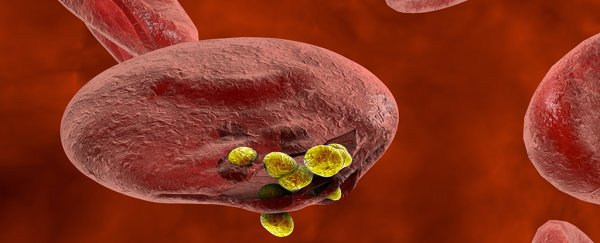Researchers have identified a simple gene variant related to human red blood cells that helps protect certain people against malaria.
The discovery sheds light on how our bodies have evolved to fight against a deadly disease that has plagued our species for millennia, and could open up the way to new treatments.
An international team of researchers led by the Wellcome Trust Centre for Human Genetics in England pooled thousands of genome sequences from ethnic groups across sub-Saharan Africa to hunt for relationships between different blood cell markers and the disease.
Malaria is caused by five species of single-celled organism belonging to the genus Plasmodium, which spread through the bite of mosquitos and then invade the host's red blood cells, or erythrocytes, to reproduce.
It's this rapid growth and traumatic popping of the red cells that causes the disease's symptoms, which include high fever, sweating, chills, and aches, and for some, death.
To get inside the cells, the parasites evolved ways to identify specific chemical receptors on the erythrocyte's surface and link up with them by producing a complex of bridging proteins.
One such bridge is currently the focus of at least one project researching potential malarial vaccines.
We have literally dozens of erythrocyte receptors, of which two you'd no doubt be familiar with; A and B, giving us blood types like A and AB, or O if you're missing both of these chemical tags.
Another one you might know is called a Rhesus factor, which we identify as a positive or negative to give us blood types like O+ or AB-.
Not all species of Plasmodium target the same receptors - for example, Plasmodium vivax looks out for a receptor called Duffy, which it links with using Duffy-binding protein.
A simple inherited mutation has meant the Duffy receptor isn't expressed in 95 percent of the West African population, helping to explain why Plasmodium vivax isn't as common in that part of the world as it is in South America and Asia.
But it's the species Plasmodium falciparum we need to watch out for, with by far the highest infection and mortality rates of all its cousins.
In 2015, malaria was responsible for taking just under half a million lives across the globe. Most of these were caused by P. falciparum.
This particular species has a whole family of bridges at its disposal to link with a diversity of receptors.
Yet two of its target blood cell receptors - based on types of glycophorin produced by the genes GYPA and GYPB - have attracted researchers' attention.
Back in 1977, researchers reported that red blood cells from people with a rare GYPA mutation seemed to resist being invaded by P. falciparum.
Since then, variations in erythrocyte receptors have been studied in relation to patterns of malarial infection in the hope of developing new insights that could lead to better treatments or ways to prevent infection.
In this latest study, the genomes of 765 individuals from populations across Gambia, Burkina Faso, Cameroon, and Tanzania were sequenced and compared with genomes from the 1000 Genomes Project, as well as 4,500 previously published genomes of individuals with severe malaria and 5,300 controls.
From this huge sample of genetic information, the researchers identified regions surrounding the glycophorin genes that had duplicated, coming up with 27 variations in copied sections.
The spread of these copy variations across the sub-Saharan populations more or less reflected the results of previous studies that found differences in their blood cell's glycophorins.
One copy in particular, duplication 4 (or simply DUP4), was associated with a resistance to severe malarial infections, lowering the risk of the disease by about 40 percent.
"This variant reduces the risk of severe malaria by 40 percent, and has recently risen in frequency in parts of Kenya, yet it appears to be absent from west Africa," the researchers write in their report.
It's not completely clear how this variation makes it harder for the parasite to get a grip, but the researchers think it might have something to do with how the copy swaps GYPB with a hybrid GYPB-A receptor, possibly changing the properties of the membrane or interfering with the bridge P. falciparum makes with the cell.
The DUP4 variation was only present in some of the African populations, raising the question of whether the mutation is recent and hasn't yet had a chance to spread, or if it only protects against certain strains of P. falciparum.
Humans and malaria have had a long history together, so it's unsurprising that our cells have been involved in an arms race with the parasites, each finding new processes to invade or hide.
Sometimes in this fight, such as with the spread of sickle-cell anaemia, the evolutionary price we've paid for protection against a deadly disease hasn't come cheap.
Yet after millions of years, we finally seem to be winning the war against malaria thanks to the widespread availability of mosquito netting and insecticides, and cheap vaccines on the horizon.
Knowing how our genes contribute could give us just one more vital advantage against this ancient, deadly foe.
This research was published in Science.
